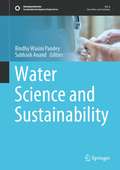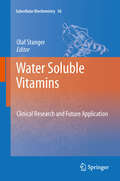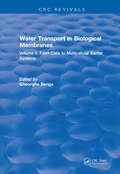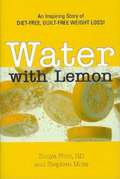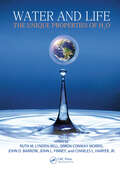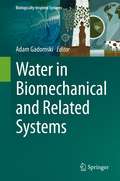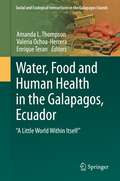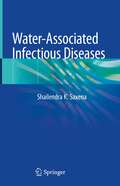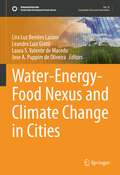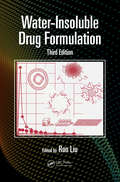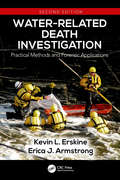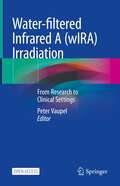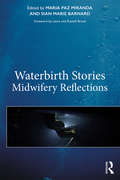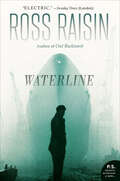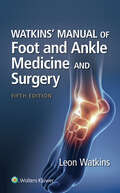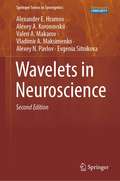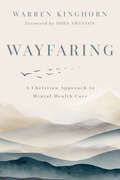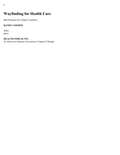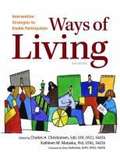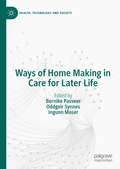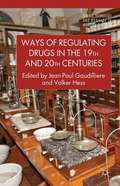- Table View
- List View
Water Science and Sustainability (Sustainable Development Goals Series)
by Subhash Anand Bindhy Wasini PandeyThis book describes the importance of water resources for socio-economic and ecological development including geomorphic and ecological environments. Hence, conservation, management and development of water resources have become necessary for the all-around development of global populations and the environment. It is the outcome of valuable contributions made by eminent scientists and research scholars who have developed alternative strategies, solutions and models for sustainable water resources through research, monitoring and experiments varying from regional to global scale. This book is of immense use to the policymakers, environmentalists, ecologists, academician, research scholars and people in general concerned with water resources management.
Water Soluble Vitamins
by Olaf StangerThe discovery of vitamins in the early 1900s, their later chemical characterization and the clarification of pivotal metabolic functions are sequential aspects of a brilliant chapter in the history of modern nutritional sciences and medicine. The name, derived from "vital-amines", indicates their elementary metabolic key functions in human metabolism. Vitamins are truly families of compounds, which include precursors and various free and bound forms, all with individual roles in metabolism and function. A more recent approach therefore searches for the components, the understanding of their roles in physiology and pathology as well as looking for novel pharmacological applications. When used properly, vitamins are, indeed, "magical" substances. Due to their efficacy, they should therefore be regarded as drugs with effects and side effects to be weighted against each other. Today, it is not the previously fatal deficiency-associated diseases that are in the focus of interest, but rather the relation of suboptimal vitamin bioavailability to chronic disease. This is complicated by genetic susceptibility, lifestyle, and the presence or absence of health-compromising habits, such as smoking. In turn, the development and application of new and more sensitive and specific assays further enable us to look more closely into the many functions of vitamins. Water soluble vitamins are complex molecular structures and even today, many areas in vitamin biochemistry are not yet fully understood. Novel effects and functions of vitamins remain and continue to be discovered. This book presents most recent research results and fascinating new knowledge on the role and effects of the water soluble vitamins in man. Some of the most distinguished chemists, biochemists, biologists and clinicians have contributed valuable chapters sharing unexpected novel insights into the biochemistry, (epi)genetics, metabolism, and function of water soluble vitamins, with their potential for clinical applications. Thus, physicians, clinicians, scientists, researchers, epidemiologists. nutritional specialists and health professionals alike will find stimulating and fascinating new insight in the many roles that water soluble vitamins play in human health and disease.
Water Transport and Biological Membranes: Volume 2
by Gheorghe BengaThe main purpose of this book is to provide in-depth presentation of physical techniques for measuring water transport and their applications to a variety of biological membranes, from model membrane systems to cell membranes, and then from isolated cells to multicellular barrier systems, such as epithelia or even whole organisms. This survey of water transport in such a broad range of membrane systems will hopefully contribute to understanding of the structure-function relationships and molecular mechanisms of water permeation. Moreover, the description of various techniques, together with a review of literature will enable the readers to assess whether a technique would be useful in helping to solve his or her particular problem of research and will also expand their competence in these techniques. The book consists of two volumes.
Water With Lemon
by Stephen Moss Zonya FocoPower of One Good Habit Water with Lemon is the first health novel in the Power of One Good Habit series. Introducing A New Genre: The Health Novel 60 extra pounds. An unhappy marriage. Food for comfort. Karen's life is falling apart. Then she meets an unlikely neighbor who reveals how a series of simple choices have the power to shape the life we have - into the life we want. Karen's story of weight loss and personal transformation will touch your heart and open your eyes! It will reveal how eight powerful, core habits, when mastered one at a time, create an invisible force that will literally - change your life. What do you get when you cross a nutritionist with a novelist? A health novel! Where nutrition, health and weight-loss information are woven into the story. Each challenge the characters face not only teaches you what to do - it inspires you to actually do it. Zonya Foco, America's Nutrition Leader, and Stephen Moss, America's Health Novelist, have joined forces to create this exciting new genre. Stephen's compelling story will keep you turning the pages while Zonya's surprisingly simple approach to mastering weight control is revealed. You'll discover that this is not another fad diet book. In fact, it's not a diet book at all. There is no diet mentality. Nothing to calculate. And never a reason to feel guilty!
Water and Life: The Unique Properties of H2O
by John D. Barrow Charles L. Harper Simon Conway Morris Ruth M. Lynden-Bell John L. FinneyReflecting a rich technical and interdisciplinary exchange of ideas, Water and Life: The Unique Properties of H20 focuses on the properties of water and its interaction with life. The book develops a variety of approaches that help to illuminate ways in which to address deeper questions with respect to the nature of the universe and our place withi
Water in Biomechanical and Related Systems (Biologically-Inspired Systems #17)
by Adam GadomskiThe contributed volume puts emphasis on a superior role of water in (bio)systems exposed to a mechanical stimulus. It is well known that water plays an extraordinary role in our life. It feeds mammalian or other organism after distributing over its whole volume to support certain physiological and locomotive (friction-adhesion) processes to mention but two of them, both of extreme relevance.Water content, not only in the mammalian organism but also in other biosystems such as whether those of soil which is equipped with microbiome or the ones pertinent to plants, having their own natural network of water vessels, is always subjected to a force field.The decisive force field applied to the biosystems makes them biomechanically agitated irrespective of whether they are subjected to external or internal force-field conditions. It ought to be noted that the decisive mechanical factor shows up in a close relation with the space-and-time scale in which it is causing certain specific phenomena to occur.The scale problem, emphasizing the range of action of gravitational force, thus the millimeter or bigger force vs. distance scale, is supposed to enter the so-called macroscale approach to water transportation through soil or plants’ roots system. It is merely related to a percolation problem, which assumes to properly inspect the random network architecture assigned to the biosystems invoked. The capillarity conditions turn out to be of prior importance, and the porous-medium effect has to be treated, and solved in a fairly approximate way.The deeper the scale is penetrated by a force-exerting and hydrated agent the more non-gravitational force fields manifest. This can be envisaged in terms of the corresponding thermodynamic (non-Newtonian) forces, and the phenomena of interest are mostly attributed to suitable changes of the osmotic pressure. In low Reynolds number conditions, thus in the (sub)micrometer distance-scale zone, they are related with the corresponding viscosity changes of the aqueous, e.g. cytoplasmatic solutions, of semi-diluted and concentrated (but also electrolytic) characteristics. For example, they can be observed in articulating systems of mammals, in their skin, and to some extent, in other living beings, such as lizards, geckos or even insects. Through their articulating devices an external mechanical stimulus is transmitted from macro- to nanoscale, wherein the corresponding osmotic-pressure conditions apply.The content of the proposed work can be distributed twofold. First, the biomechanical mammalian-type (or, similar) systems with extraordinary relevance of water for their functioning will be presented, also including a presentation of water itself as a key physicochemical system/medium. Second, the suitably chosen related systems, mainly of soil and plant addressing provenience, will be examined thoroughly. As a common denominator of all of them, it is proposed to look at their hydrophobic and/or (de)hydration effects, and how do they impact on their basic mechanical (and related, such as chemo-mechanical or piezoelectric, etc.) properties. An additional tacit assumption employed throughout the monograph concerns statistical scalability of the presented biosystems which is equivalent to take for granted a certain similarity between local and global system’s properties, mostly those of mechanical nature. The presented work’s chapters also focus on biodiversity and ecological aspects in the world of animals and plants, and the related systems. The chapters’ contents underscore the bioinspiration as the key landmark of the proposed monograph.
Water, Food and Human Health in the Galapagos, Ecuador: "A Little World Within Itself" (Social and Ecological Interactions in the Galapagos Islands)
by Amanda L. Thompson Valeria Ochoa-Herrera Enrique TeranIn this book, we bring together interdisciplinary scholars and clinicians in medicine, public health, anthropology, nutrition, environmental sciences, and geography from the University of North Carolina at Chapel Hill, Universidad San Francisco de Quito, the Ministry of Health and the Hospital Oskar Jandl. Together, these authors provide a comprehensive description of the factors shaping water quality, food availability, and health services on the islands, their implications for human health and well-being, and potential avenues for intervention.
Water-Associated Infectious Diseases
by Shailendra K. SaxenaThis book provides a comprehensive overview of the different water-associated infectious diseases and their linked pathogens with plausible strategies for their mitigation. Although, we are in the era of 21st century having most of the advanced technologies at hand, yet water-associated infectious diseases are the major contributors towards the worldwide morbidity and mortality. The book also focuses on the various implementation strategies of sustainable hygienic conditions, discusses the robust, and reliable policies and strategies on a global aspect to provide unprivileged people access to the basic sanitation, hygiene and water. In addition, the book discusses the possible indirect effect of global warming on the spread of infectious diseases through the distribution of associated vectors.
Water-Energy-Food Nexus and Climate Change in Cities (Sustainable Development Goals Series)
by Jose A. Puppim de Oliveira Leandro Luiz Giatti Lira Luz Benites Lazaro Laura S. Valente de MacedoThis book aims to contribute to the transdisciplinary study of the water-energy-food (WEF) nexus in cities and to help policy makers adopt a more integrated approach to natural resources management in urban environments to face the challenges and threats of climate change. This approach is based on a multidimensional scientific framework that seeks to understand the complex and non-linear interrelationships and interdependencies between water-energy-food under climate change and to generate solutions to reduce trade-offs among development goals and generate co-benefits that help encourage sustainable development and contribute to the achievement of SDGs, mainly SDG 11 (make cities and human settlements inclusive, safe, resilient and sustainable) and SDG 13 (take urgent action to combat climate change and its impacts).Governing the WEF nexus in cities is one of the greatest resource challenges of our time, as cities consume large amounts of WEF, but one that can also generate relevant alternatives with which to tackle climate change. To help fostering these alternatives, this book analyzes the governance, institutional and political economy factors that determine the effectiveness of the nexus approach and reviews the potential, the benefits and the policy implications of the adoption of the WEF nexus approach at the urban level. Through a series of hands-on cases, chapters in this book present the opportunities of the WEF nexus approach to achieve innovation and transformative change and discuss concrete areas of synergy and policy initiative to raise urban resilience. Water-Energy-Food Nexus and Climate Change in Cities will serve both as a guide for policy makers as well as a useful resource for students and researchers in fields such as urban studies, public health, environmental sciences, energy studies and public policy interested in learning how cities can represent possibilities to navigate and manage sustainability from local to global.
Water-Insoluble Drug Formulation
by Rong Ron LiuProperties and Formulation: From Theory to Real-World Application Scientists have attributed more than 40 percent of the failures in new drug development to poor biopharmaceutical properties, particularly water insolubility. Issues surrounding water insolubility can postpone or completely derail important new drug development. Even the much-needed reformulation of currently marketed products can be significantly affected by these challenges. More recently it was reported that the percentage increased to 90% for the candidates of new chemical entities in the discovery stage and 75% for compounds under development. In the most comprehensive resource on the topic, this third edition of Water-Insoluble Drug Formulation brings together a distinguished team of experts to provide the scientific background and step-by-step guidance needed to deal with solubility issues in drug development. Twenty-three chapters systematically describe the detailed discussion on solubility theories, solubility prediction models, the aspects of preformulation, biopharmaceutics, pharmacokinetics, regulatory, and discovery support of water-insoluble drugs to various techniques used in developing delivery systems for water-insoluble drugs. This book includes more than 15 water-insoluble drug delivery systems or technologies, illustrated with case studies and featuring oral and parenteral applications. Highlighting the most current information and data available, this seminal volume reflects the significant progress that has been made in nearly all aspects of this field. The aim of this book is to provide a handy reference for pharmaceutical scientists in the handling of formulation issues related to water-insoluble drugs. In addition, this book may be useful to pharmacy and chemistry undergraduate students and pharmaceutical and biopharmaceutical graduate students to enhance their knowledge in the techniques of drug solubilization and dissolution enhancement.
Water-Related Death Investigation: Practical Methods and Forensic Applications
by Kevin L. Erskine Erica J. ArmstrongNearly ten years after the first edition of Water-Related Death Investigation: Practical Methods and Forensic Applications, water death cases continue to be improperly investigated. The pathologist’s report can determine the cause of death as a drowning, but the manner of death is the most challenging to prove. The report will not determine if a victim jumped into the water to commit suicide, fell into the water accidentally, or was pushed in as a homicidal act. Many drowning cases do not reflect injury to the body, so evidence collected at the scene plays a vital role. The importance of an on-scene body assessment cannot be overemphasized. Often, the body evidence begins to change rapidly upon recovery and may not be present during an autopsy. Written statements on the scene are an effective tool to use to determine the accuracy of information given to arriving officers. These statements need to be written by the witnesses themselves as well as the reporting person. The "Show Me" technique can also help reveal discrepancies in a person’s version of what occurred as well as aid in providing the most details to an incident as is humanly possible. This second edition includes updated information on the latest technology to assist water death investigators. Parabon Snapshot can help determine the faceless identity of skeletal remains and help locate potential suspects using the science of DNA. Drones can aid in locating missing persons as well as human remains, even months after death. Updated information is provided regarding fingerprints from submerged objects, and Carbon-14 can help determine the origin of a found corpse. Key Features: Thoroughly reviews the physiological aspects of drowning Reveals the investigative characteristics inherent to various scenes of water-related deaths Highlights certain "red flag" indicators that may point to foul play or scene staging Outlines autopsy protocols, trial preparation, and expert witness testimony Provides numerous case studies and numerous illustrations to further clarify key points presented in the text Coauthored by a Master Water Death Investigator and an experienced forensic pathologist, Water-Related Death Investigation: Practical Methods and Forensic Applications, Second Edition merges the essentials of evidence collection and field investigation with autopsy best practices and laboratory testing. It will continue to serve as a valuable resource for the various professionals involved in these cases.
Water-filtered Infrared A (wIRA) Irradiation: From Research to Clinical Settings
by Peter VaupelThe aim of this open access book is to provide a unique, timely, critical and comprehensive compilation of more than 30 years of robust international experimental and clinical research related to the basic science and therapeutic application of water-filtered infrared-A (wIRA) and hyperthermia in oncology, psychiatry (depression), musculoskeletal disorders, dermatology, infectiology, and surgery. This is an internationally absolutely unique attempt which publication is timely and of great interest in medical as well as in natural sciences. The aim is to enhance communication and advance the use of heat therapy for patient benefit, and to generate an environment in which anyone with an interest in hyperthermia can discuss, collaborate, network, and share events and resources. Productive dialogue and discussion among scientists and practitioners on issues relating to hyperthermia therapy is essential, especially relating to thermal transmission by water-filtered infrared-A (wIRA). The specificity and advantage of this technology is its tolerance by tissue, and its penetration of up to 3 cm allows the delivery of high heat dosages that are relevant across multiple clinical indications. Currently, wIRA is being applied in Austria, Germany, Portugal, Switzerland, The Netherlands, UK and the USA. The authors’ hope is that its use will increase in these countries, and also expand into others. This book will be an invaluable tool for oncologists, surgeons, dermatologists as well as physiotherapists.
Water: Healer or Poison?
by Jan de VriesWater is one of the basic necessities of life - no organism can survive in its absence. In recent years, however, it has become increasingly clear that our public water supply is not as pure as it should be and many are questioning its high chemical content. 'Water scares' are becoming all too frequent. Beaches, seas and oceans themselves are being increasingly contaminated. Plankton are beginning to die and the Earth is being deprived of one of its primary sources of oxygen. In this important addition to his Nature's Gift series, Jan de Vries discusses the implications of this self-inflicted damage and points out the health risks of the various forms of water contamination. Yet, in its pure form, water is one of nature's greatest healers and this volume draws on Jan de Vries' extensive experience of the various water-treatment methods. It provides his readers with guidance and sensible advice on the benefits to be gained from pure, unadulterated water, and it's safe use. Anyone who has been perturbed or confused by the conflicting reports and guidelines concerning this important issue will welcome such an informative book.
Waterbirth Stories: Midwifery Reflections
by Maria Miranda Sian BarnardDrawing on years of midwifery experience of waterbirth, this collection of stories, based on real-life events, illuminates a rewarding way of birth and emphasises the theoretical knowledge, skills, understanding, and resilience needed to practice well. Waterbirth Stories includes chapters on the criteria for use of water in labour and birth, on the different stages of labour, and on some more serious or unusual situations such as shoulder dystocia, postpartum haemorrhage, breech presentation, and other unexpected maternal and neonatal events. Each chapter includes several stories from a midwife’s perspective, told in the context of evidence-based guidelines available for this topic. The stories end with learning points to help readers reflect on their own practice. Ideal for student and practising midwives with an interest in waterbirth, this research-informed book is enjoyable, challenging, and informative.
Waterline: A Novel
by Ross RaisinFrom Ross Raisin, the highly acclaimed author of Out Backward—a debut novel Colm Tóibín called “compelling, disturbing and often very funny”—comes the moving and story of an ex-shipyard worker’s journey of grief and reclamation in the wake of his wife’s death. Lyrical and resonant, with echoes of Paul Harding’s Tinkers and Anne Enright’s The Gathering, Raisin’s blue collar story of a man’s fractured search for a new beginning is a powerfully voiced, penetratingly personal narrative of alienation and, ultimately, redemption. “Ross Raisin confirms himself as an exciting talent, a unique, gifted, and generous voice, a young writer with a vision broad far beyond his years.” —David Vann, Financial Times
Watershed: Attending to Body and Earth in Distress
by Ranae Lenor HansonA personal health crisis, stories from environmental refugees, and our climate in danger prompt a meditation on intimate connections between the health of the body and the health of the ecosystem The body of the earth, beset by a climate in crisis, experiences drought much like the human body experiences thirst, as Ranae Lenor Hanson&’s body did as a warning sign of the disease that would change her life: Type 1 diabetes. What if we tended to an ailing ecosystem just as Hanson learned to care for herself in the throes of a chronic medical condition. This is the possibility explored in a work that is at once a memoir of illness and health, a contemplation of the surrounding natural world in distress, and a reflection on the ways these come together in personal, local, and global opportunities for healing.Beginning with memories from a childhood nurtured among the waters of Minnesota, Watershed follows the streams and tributaries that connect us to our world and to each other, as revealed in the life stories of Hanson&’s students, Minnesotans driven from their faraway homelands by climate disruption. The book&’s currents carry us to threatened mangrove swamps in Saudi Arabia, to drought-stricken Ethiopia, to rocks bearing ancient messages above crooked rivers in northern Minnesota, to a diabetic crisis in an ICU bed at a St. Paul hospital. With the benefit of gentle insight and a broad worldview, Hanson encourages us at every turn to find our own way, to discover how the health of our bodies and the health of the world they inhabit are inextricably linked and how attending, and tending, to their shared distress can lead to a genuine, grounded wellbeing. When, in the grip of a global pandemic, humans drastically change their behavior to preserve human life, we also see how the earth breathes more freely as a result. In light of that lesson, Watershed helps us to consider our place and our part in the health and healing of the world around us.
Watkins' Manual of Foot and Ankle Medicine and Surgery
by Leon WatkinsIdeal for podiatry residents, students, and practitioners, Watkins’ Manual of Foot and Ankle Medicine and Surgery, Fifth Edition, provides fast access to must-know clinical information on anatomy, pharmacology, microbiology, disease prevention, and management of foot and ankle disorders. Author and illustrator, Dr. Leon Watkins, offers concise yet comprehensive coverage of everything you need to know—from arthritis, imaging, and wound care to implants, pediatrics, and trauma, all in an easy-to-digest list format that makes study, review, and reference quick and easy.
Wavelets in Neuroscience (Springer Series in Synergetics)
by Alexander E. Hramov Alexey A. Koronovskii Valeri A. Makarov Alexey N. Pavlov Evgenia Sitnikova Vladimir A. MaksimenkoThis book illustrates how modern mathematical wavelet transform techniques offer fresh insights into the complex behavior of neural systems at different levels: from the microscopic dynamics of individual cells to the macroscopic behavior of large neural networks. It also demonstrates how and where wavelet-based mathematical tools can provide an advantage over classical approaches used in neuroscience. The authors well describe single neuron and populational neural recordings.This 2nd edition discusses novel areas and significant advances resulting from experimental techniques and computational approaches developed since 2015, and includes three new topics:• Detection of fEPSPs in multielectrode LFPs recordings.• Analysis of Visual Sensory Processing in the Brain and BCI for Human Attention Control;• Analysis and Real-time Classification of Motor-related EEG Patterns;The book is a valuable resource for neurophysiologists and physicists familiar with nonlinear dynamical systems and data processing, as well as for graduate students specializing in these and related areas.
Way Out: Was hilft und was heilt
by Andrea Brummack Dagmar KlinkDieser Ratgeber zeigt, was Eltern, Angehörige, aber auch Sozialpädagog*innen, Erzieher*innen und Lehrer*innen tun können, damit Kinder sexuelle Übergriffe gut verarbeiten und die traumatischen Folgen gelindert werden. Andrea Brummack und Dagmar Klink stellen Geschichten und Fallberichte von Kindern vor, die ihren Weg aus gefährlichen Ereignissen und Konflikten gefunden haben, sowie praktische Tipps und Prinzipien, um sexuelle Traumata zu lösen. Der Fokus liegt dabei auf zwei wichtigen Elementen: dem Umgang mit der durch den Schrecken verlorenen Sprache der Kinder sowie der Rolle des Tastsinns bei der Wiederherstellung positiver Assoziationen mit Berührung.
Wayfaring: A Christian Approach to Mental Health Care
by Warren KinghornA theologically and scientifically engaged exploration of modern mental health care The current model of mental health care doesn&’t see people: it sees sets of symptoms that need fixing. While modern psychiatry has improved many patients&’ quality of life, it falls short in addressing their relational and spiritual needs. As a theologian and practicing psychiatrist, Warren Kinghorn shares a Christian vision of accompanying those facing mental health challenges. Kinghorn reviews the successes and limitations of modern mental health care before offering an alternative paradigm of healing. Based in the theology of Thomas Aquinas, this model of personhood affirms four truths: We are known and loved by God. We are creatures made of earth who are formed in community. We are wayfarers on a journey. We are called not to control, but to wonder, love, praise, and rest. Drawing on theological wisdom and scientific evidence, Kinghorn reframes our understanding of mental health care from fixing machines to attending fellow wayfarers on the way to the Lord&’s feast. With gentle guidance and practical suggestions, Wayfaring is an essential resource for pastors and practitioners as well as for Christians who seek mental health care.
Wayfinding For Health Care: Best Practices For Today's Facilities
by Randy CooperA pragmatic book that exclusively covers wayfinding at health care facilities. It serves as a guide to stimulate thinking and highlights projects that illustrate how wayfinding projects at existing or planned facilities can be put on track quickly and successfully. It clearly builds the case that proper wayfinding protocols have an immensely positive impact on staff, patient and visitor behaviors and perceptions and ultimately affect patient satisfaction, staff morale and an organization s bottom line.
Ways Of Living: Intervention Strategies To Enable Participation
by Charles H. Christiansen Kathleen M. MatuskaForlagets beskrivelse: Students often say, "I studied 40 hours for this exam and I still didn't do well. Where did I go wrong?" Most instructors hear this complaint every year. In many cases, it is true that the student invested countless hours, only to produce abysmal results. Often, inefficient study habits are to blame. The important question is: why do so many students have difficulty preparing themselves for organic chemistry exams? There are certainly several factors at play here, but perhaps the most dominant factor is a fundamental disconnect between what students learn and the tasks expected of them. To address the disconnect in organic chemistry instruction, David Klein has developed a textbook that utilizes a skills-based approach to instruction. The textbook includes all of the concepts typically covered in an organic chemistry textbook, but special emphasis is placed on skills development to support these concepts. This emphasis upon skills development will provide students with a greater opportunity to develop proficiency in the key skills necessary to succeed in organic chemistry. As an example, resonance structures are used repeatedly throughout the course, and students must become masters of resonance structures early in the course. Therefore, a significant portion of chapter 1 is devoted to drawing resonance structures. Two chapters (6 and 12) are devoted almost entirely to skill development. Chapter 6 emphasizes skills that are necessary for drawing mechanisms, while chapter 12 prepares the student for proposing syntheses. In addition, each chapter contains numerous Skillbuilders, each of which is designed to foster a specific skill. Each skillbuildercontains three parts: 1. Learn the Skill: a solved problem that demonstrates a particular skill; 2. Practice the Skill: numerous problems (similar to the solved problem) that give the students an opportunity to practice and master the skill; 3. Apply the Skill: one or two more-challenging problems in which the student must apply the skill in a slightly different environment. These problems include conceptual, cumulative, and applied problems that encourage students to think out of the box. Sometimes problems that foreshadow concepts introduced in later chapters are also included. All SkillBuilders are visually summarized at the end of each chapter (Skillbuilder review), followed by a list of suggested in-chapter and end-of-chapter practice problems.
Ways You Can Help: Creative, Practical suggestions for Family and Friends of Patients and Caregivers
by Margaret CookeThoughtful ideas for brightening the day of patients and caregivers.
Ways of Home Making in Care for Later Life (Health, Technology and Society)
by Bernike Pasveer Oddgeir Synnes Ingunn MoserThis is a book on how home is made when care enters the lives of people as they grow old at home or in ‘homely’ institutions. Throughout the book, contributors show how home is a verb: it is something people do. Home is thus always in the making, temporal, contested, and open to negotiation and experimentation. By bringing together approaches from STS, anthropology, health humanities and health care studies, the book points to the importance of people's tinkerings and experiments with making home, as it is here that home is being made and unmade.
Ways of Regulating Drugs in the 19th and 20th Centuries
by Jean-Paul Gaudillière Volker HessThis collection takes the perspective that the historiography of science, technology, and medicine needs a broader approach toward regulation. The authors explore the distinct social worlds involved in regulation, the forms of evidence and expertise mobilized, and means of intervention chosen to tame drugs in factories, consulting rooms and courts.
